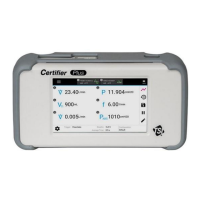Touchscreen Operation 4-9
Flow Rate – Manual Triggers
If auto-triggering is not providing reasonable results, consider using manual flow triggering. Press the
Auto Trigger box to unselect it and be able to specify flow rate values for the start and end of the
breath. A positive slope through the first value is used for the start of inspiratory and a negative slope
through the second value used for the start of expiratory. End
Start
To optimize manual flow trigger values, it can be helpful to view the Flow Rate waveform plotted on
the Graph screen or observe the flow waveform from the ventilator being tested. Refer to
section Editing the Graph Screen for more information on graphing waveforms.
Pressure – Manual Triggers
This trigger type is intended to give advanced users additional setup options for testing high frequency
ventilators or other setups in which flow rate or auto-triggering are not ideal. Note that auto-triggering
is not available for pressure.
To trigger using the low pressure, select the Pressure radio button option. A positive slope through
the first value is used for the start of inspiratory and a negative slope through the second value used
for the start of expiratory. For robust triggering, always set tEndStart
To optimize manual pressure trigger values, it can be helpful to view the Low Pressure waveform
plotted on the Graph screen or observe the pressure waveform from the ventilator being tested. Refer
to section Editing the Graph Screen for more information on graphing waveforms.
TTL Trigger
The start and end of the breath can also be triggered by a TTL voltage signal given at the connector
on the Plus High Flow Module labeled Trigger Input
High Flow Module. The connector is a 3.5 mm mono audio jack plug. To trigger using TTL voltage,
select the Flow Direction (TTL) radio button option and select the TTL voltage.

